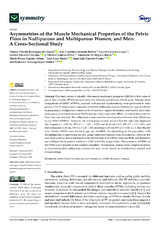Mostrar el registro sencillo del ítem
Asymmetries of the Muscle Mechanical Properties of the Pelvic Floor in Nulliparous and Multiparous Women, and Men: A Cross-Sectional Study
| dc.contributor.author | Rodrigues-de-Souza, Daiana Priscila | |
| dc.contributor.author | Sartorato Beleza, Ana Carolina | |
| dc.contributor.author | García-Luque, Lourdes | |
| dc.contributor.author | Alcaraz-Clariana, Sandra | |
| dc.contributor.author | Carmona-Pérez, Cristina | |
| dc.contributor.author | Miguel-Rubio, Amaranta de | |
| dc.contributor.author | Garzón-Alfaro, María Teresa | |
| dc.contributor.author | Cruz-Medel, Inés | |
| dc.contributor.author | Garrido Castro, Juan Luis | |
| dc.contributor.author | Alburquerque Sendín, Francisco | |
| dc.date.accessioned | 2022-10-13T08:31:42Z | |
| dc.date.available | 2022-10-13T08:31:42Z | |
| dc.date.issued | 2022 | |
| dc.identifier.uri | http://hdl.handle.net/10396/24104 | |
| dc.description.abstract | This study aimed to identify if the muscle mechanical properties (MMPs) of both sides of pelvic floor muscles (PFMs) are symmetrical in different populations of both sexes. Between-sides comparisons of MMPs of PFMs, assessed with manual myotonometry, were performed in three groups, with 31 subjects each, composed of healthy nulliparous women (without any type of delivery or pregnancy), multiparous women (with at least two vaginal deliveries), and healthy adult men. Intra-group correlations between MMPs and age, body mass index (BMI), or clinical state of pelvic floor were also obtained. The nulliparous women and the men showed no between-sides differences in any MMP of PFMs. However, the multiparous women showed that the right side displayed less frequency (−0.65 Hz, 95% CI = −1.01, −0.20) and decrement (0.5, 95% CI = 0.11, 0.01), and more relaxation (1.00 ms, 95% CI = 0.47, 1.54) and creep (0.07 De, 95% CI = 0.03, 0.11), than the left side. Further, MMPs were related to age, sex, and BMI, also depending on the population, with the multiparous women being the only group with some between-sides asymmetries, which in this case were positive and of fair intensity for the left side of the PFMs, between BMI, and frequency and stiffness (rho Spearman coefficient: 0.365 and 0.366, respectively). The symmetry of MMPs of the PFMs could depend on the subject’s condition. Multiparous women show a higher tendency to asymmetries than nulliparous women and men, which should be considered in research and clinical settings. | es_ES |
| dc.format.mimetype | application/pdf | es_ES |
| dc.language.iso | eng | es_ES |
| dc.publisher | MDPI | es_ES |
| dc.rights | https://creativecommons.org/licenses/by/4.0/ | es_ES |
| dc.source | Symmetry, 14(10), 2124 (2022) | es_ES |
| dc.subject | Pelvic floor disorders | es_ES |
| dc.subject | Manual tonometry | es_ES |
| dc.subject | Childbirth | es_ES |
| dc.subject | Issue damage | es_ES |
| dc.title | Asymmetries of the Muscle Mechanical Properties of the Pelvic Floor in Nulliparous and Multiparous Women, and Men: A Cross-Sectional Study | es_ES |
| dc.type | info:eu-repo/semantics/article | es_ES |
| dc.relation.publisherversion | https://doi.org/10.3390/sym14102124 | es_ES |
| dc.rights.accessRights | info:eu-repo/semantics/openAccess | es_ES |

